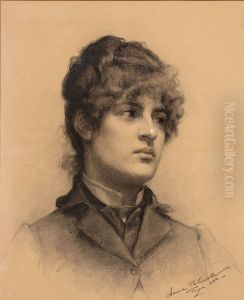Anna Bilinska-Bohdanowicz Paintings
Anna Bilińska-Bohdanowicz was a prominent Polish painter known for her remarkable contributions to portrait painting and genre scenes in the late 19th century. Born on May 18, 1857, in Złotopol, in the Russian Empire (now Ukraine), she moved to Warsaw with her family, where she began her artistic education. Despite the limited opportunities available for women in the arts during this period, Bilińska-Bohdanowicz's talent and determination led her to pursue further studies abroad. In 1882, she moved to Paris, which was then the epicenter of the art world. There, she enrolled at the Académie Julian, a progressive art school that accepted female students, studying under influential figures such as Tony Robert-Fleury and William-Adolphe Bouguereau. During her time in Paris, Bilińska-Bohdanowicz developed a distinctive style characterized by meticulous detail, realistic portrayal of her subjects, and a subtle use of light. Her works often depicted women in introspective moments, capturing their inner lives with sensitivity and depth. Bilińska-Bohdanowicz's talent was recognized with several awards and her participation in major exhibitions, including the Paris Salon, where she received notable accolades. Despite her success in France, she maintained strong ties to Poland, contributing to the development of the Polish art scene and participating in exhibitions in Krakow and Warsaw. In 1886, she married a Polish doctor, Antoni Bohdanowicz, and briefly moved back to Warsaw. Tragically, Anna Bilińska-Bohdanowicz's life and career were cut short when she died of a heart condition on April 18, 1893, at the age of 36. Despite her brief career, she left behind a significant body of work that continues to be celebrated for its contribution to Polish and European art. Her legacy is preserved in the collections of major museums in Poland and abroad, and she remains an inspiring figure for women in the arts.























